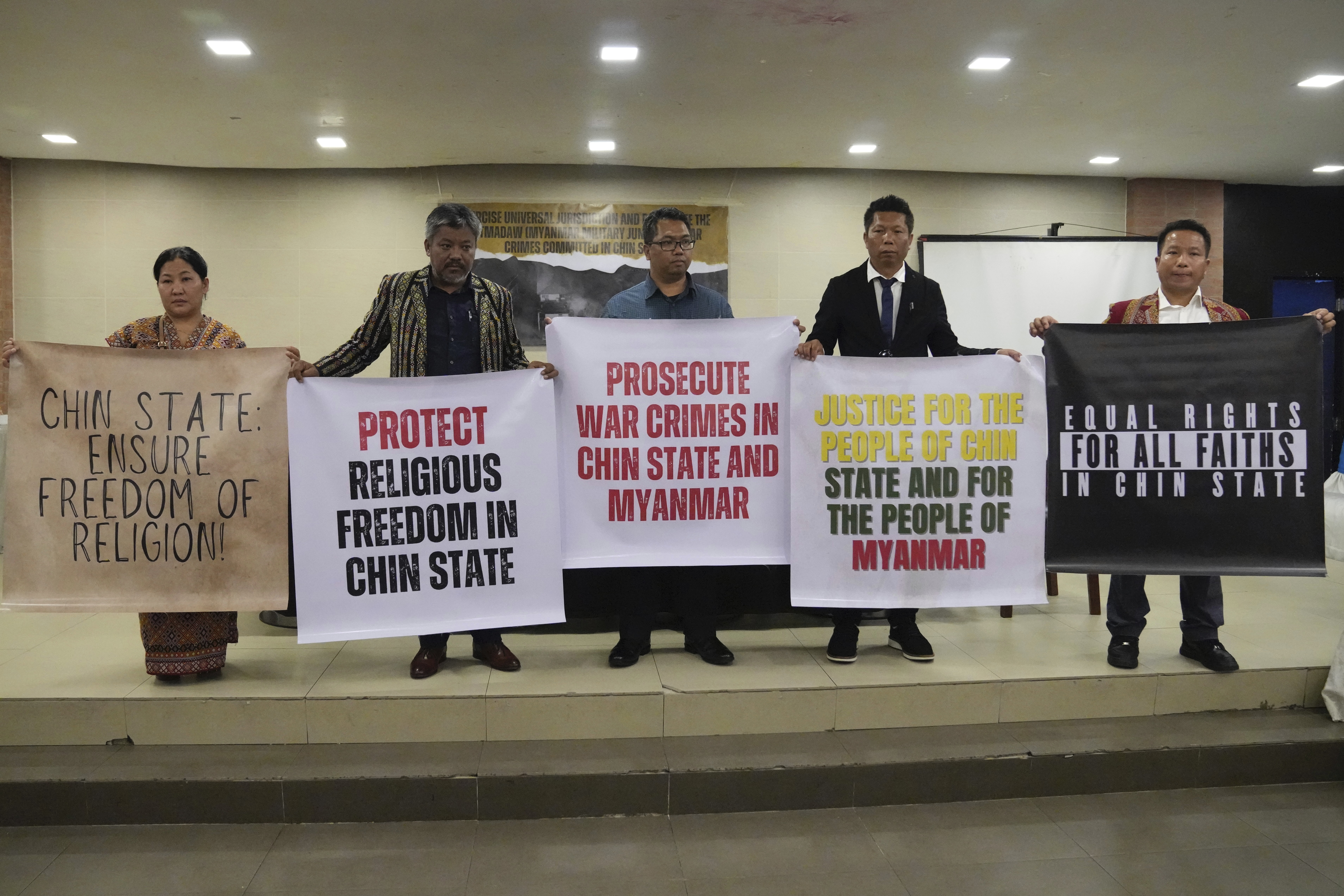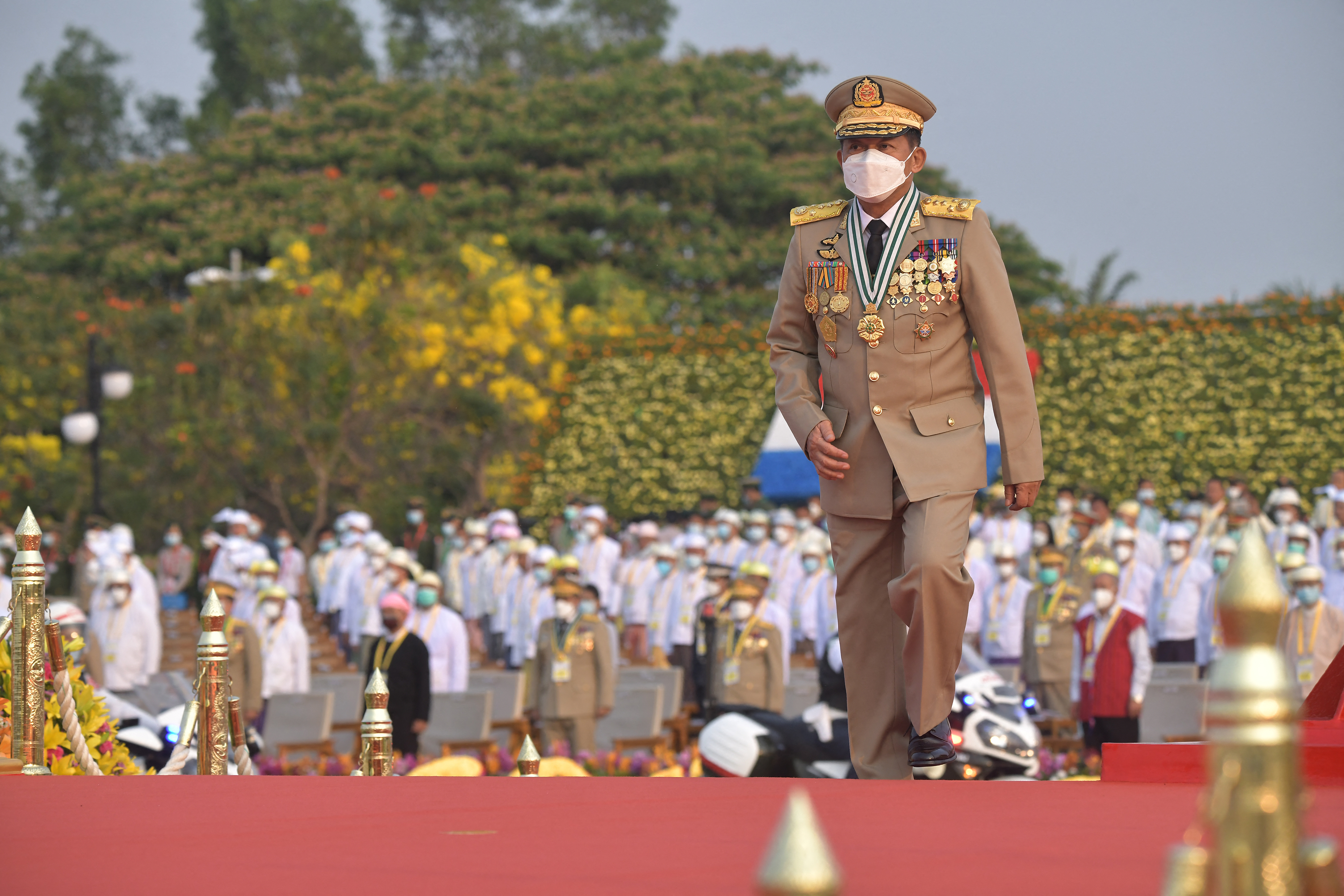
Early one morning in March, a group of Myanmar soldiers marched into a village in the country’s east near the border with Thailand.
They had been engaged in days of intense fighting with armed groups opposed to the February 2021 coup – in which the military deposed Aung San Suu Kyi and other democratically elected leaders and took power – subjecting the area to intense shelling and aerial bombardment.
Many of the people of Nam Neang village had taken refuge in the surrounding jungle but 18 had sought sanctuary with three monks in the temple, according to the Shan Human Rights Foundation.
On March 11, the soldiers surrounded the temple and demanded those inside come out.
They “shot them dead … took photos of the corpses and shared the photos on social media”, said the foundation, adding that the soldiers claimed to have killed anti-coup fighters.
The incident, a crime under international law, is only one of a number of abuses to have taken place by troops under the command of Lieutenant-General Aung Aung, according to research released on Wednesday by Security Force Monitor (SFM), a project of the Columbia Law Human Rights Institute in the United States.
The study, Under Whose Command?, covers a period of 12 years until March 30, 2023 and sheds new light on Myanmar’s notoriously secretive military – revealing the links between low-level soldiers accused of human rights abuses against civilians and their commanding officers and beyond.
“In many areas of the country, almost every single person who ever held command had disappearances, killings, rape or instances of torture allegedly committed by units under their command,” the report said. “This is particularly true in areas of longstanding conflict and concern for human rights abuses.”
In Aung Aung’s case, the incident in Nam Neang was not the first under his watch.
He was in charge of the 33rd Light Infantry Division, which has been linked to the 2017 crackdown on the Rohingya that is now the subject of a genocide investigation at the International Court of Justice (ICJ).
After that, he was given command control of the South Western Command before being made a Lieutenant General in October 2022 and promoted to lead the Bureau of Special Operations 2, which covers operations in the country’s east and northeast.
‘It is quite shocking to see the scale of this, and the stunning number of violations over time,” Tony Wilson, the founder and director of SFM and the lead researcher on the project told Al Jazeera. “You see the same pattern play out over again and the same units commit the same kinds of violations even when the commander has changed.”
Building a picture
Trawling through thousands of data sources from March 30, 2011 when Senior General Min Aung Hlaing became Commander-in-Chief, the research found 64 percent (51 of 79) of all senior army commanders had alleged disappearances, killings, rape or instances of torture committed by units under their command.
In addition, 54 percent (28 of 51) of the commanders were promoted in rank after at least one alleged disappearance, killing, rape or instance of torture was committed by the units under their command. Of the others, nine could not be promoted in rank further.
“It’s about building a picture; that it’s a system of control exercised from the top,” Wilson said.


Other Myanmar experts who were not involved in the research said the work could be useful for accountability and building war crimes and genocide cases against the armed forces.
“It’s not a few rogue elements. It’s a majority of senior commanders,” Thomas Kean, a Myanmar expert with Crisis Group, told Al Jazeera.
The February 2021 coup plunged Myanmar into crisis after the generals responded to mass protests against its power grab with brutal force, and opponents joined forces with fighters from long-established ethnic armed groups in a bid to restore civilian rule.
Following its strategy of “four cuts” or “clearance operations”, the military has sought to cut off their opponents’ access to food, funds, intelligence and recruits.
First used against the ethnic Karen in the 1960s, it was also deployed in northwestern Rakhine state in August 2017 against the mostly Muslim Rohingya.
Hundreds of thousands fled across the border into Bangladesh as soldiers burned down entire villages, and carried out killings and acts of sexual violence.
“[The research] furthers the case that the top brass of the Tatmadaw [the Myanmar military] must have known what was going to happen when they promoted these people. The outcome had to be genocidal if you put these particular military figures in these roles,” Ronan Lee, an expert on Myanmar and the Rohingya at Loughborough University London, told Al Jazeera.
“It’s like any job – you choose the person who you think will do the job. The Tatmadaw knew it was choosing people with a track record of committing atrocity crimes against civilians.”

Since the coup, investigators have accused the military of similar tactics in areas, such as the central Sagaing region, where the anti-coup resistance has been particularly strong.
The Independent Investigative Mechanism for Myanmar (IIMM), a United Nations body set up in 2018 to collect evidence on suspected atrocity crimes in the Southeast Asian nation of 53 million people, warned in August that war crimes committed by Myanmar’s military, including mass executions and sexual violence, had become “increasingly frequent and brazen”.
It said it had documented “widespread and systematic attacks against civilians” and that it was building case files to be used to hold individual perpetrators responsible”.
Violations over a sustained period
While the ICJ case is the most advanced of the international actions, cases have also been filed under universal jurisdiction from South America to Europe and Southeast Asia. Last week, a group of ethnic Chin people from Myanmar filed a case in Manila against Ming Aung Hlaing and eight of his military commanders over the post-coup crackdown in the northwestern state.
Among the other incidents documented in the SFM report is an alleged shelling attack on two Mon civilians by a battalion under the Southeastern Regional Military Command. The study traces the chain of command from the alleged perpetrator up to the regional commander, Myat Thet Oo.

It said the research suggested the killings were “part of a pattern” and that in the past 12 years, five of the six commanders of Southeastern Regional Military Command (where the incident occurred) had had at least one allegation of killing, rape, or torture committed by units under their command.
The research also documented the entire chain of command behind the 2015 rape, torture and killing of two Kachin teachers in northeastern Myanmar. At the time, local villagers said the army’s 503rd Light Infantry Battalion was stationed near the village when the women were killed.
Wilson said he hoped SFM research would help support legal action and ensure justice for those who had lost loved ones as a result of the military’s actions.
“This is a large number of commanders over a long period of time and all of them have violations,” he said.







